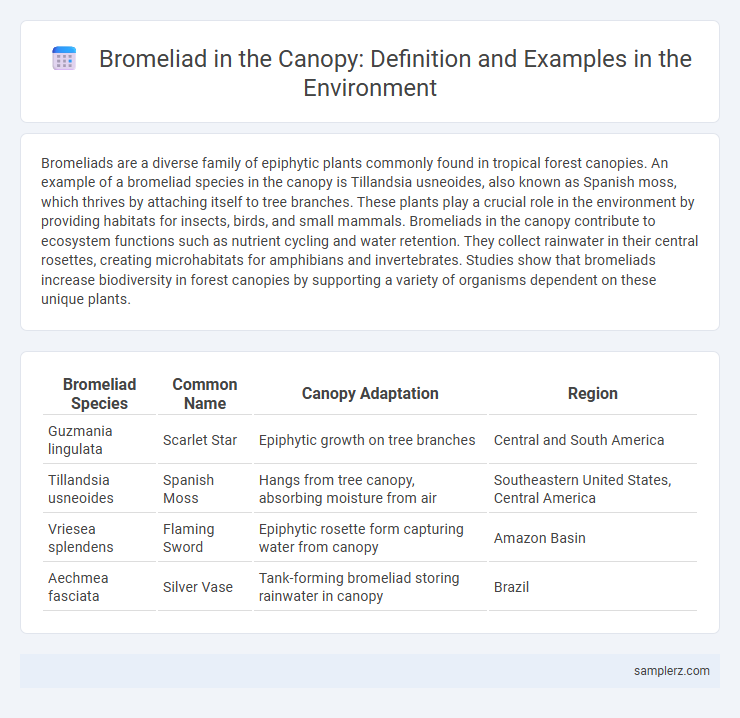Bromeliads are a diverse family of epiphytic plants commonly found in tropical forest canopies. An example of a bromeliad species in the canopy is Tillandsia usneoides, also known as Spanish moss, which thrives by attaching itself to tree branches. These plants play a crucial role in the environment by providing habitats for insects, birds, and small mammals. Bromeliads in the canopy contribute to ecosystem functions such as nutrient cycling and water retention. They collect rainwater in their central rosettes, creating microhabitats for amphibians and invertebrates. Studies show that bromeliads increase biodiversity in forest canopies by supporting a variety of organisms dependent on these unique plants.
Table of Comparison
| Bromeliad Species | Common Name | Canopy Adaptation | Region |
|---|---|---|---|
| Guzmania lingulata | Scarlet Star | Epiphytic growth on tree branches | Central and South America |
| Tillandsia usneoides | Spanish Moss | Hangs from tree canopy, absorbing moisture from air | Southeastern United States, Central America |
| Vriesea splendens | Flaming Sword | Epiphytic rosette form capturing water from canopy | Amazon Basin |
| Aechmea fasciata | Silver Vase | Tank-forming bromeliad storing rainwater in canopy | Brazil |
Introduction to Bromeliads in Forest Canopies
Bromeliads like Tillandsia usneoides thrive in forest canopies by absorbing moisture and nutrients directly from the air, showcasing their epiphytic adaptation. These plants play a crucial role in canopy ecosystems by providing habitats and water reservoirs for various insects and amphibians. Their ability to survive in nutrient-poor environments makes them essential components of tropical and subtropical forest biodiversity.
Unique Adaptations of Canopy Bromeliads
Canopy bromeliads like Tillandsia usneoides demonstrate unique adaptations such as absorbing moisture and nutrients directly from the air through trichomes, enabling survival in nutrient-poor environments. Their tank-like leaf rosettes collect rainwater, providing habitats for diverse microfauna and promoting ecosystem biodiversity. These adaptations enhance their resilience to fluctuating canopy conditions and contribute to nutrient cycling within tropical forests.
Tillandsia: Iconic Air Bromeliads of the Canopy
Tillandsia, often called air bromeliads, thrive in the canopy as epiphytes absorbing moisture and nutrients from the air, showcasing remarkable adaptation to arboreal life. These bromeliads contribute to ecological balance by providing microhabitats for insects and small animals, enhancing biodiversity in forest canopies. Their unique trichomes enable efficient water uptake, making Tillandsia vital components of tropical and subtropical ecosystems.
Guzmania Species: Bright Canopy Residents
Guzmania species, vibrant bromeliads native to tropical rainforests, thrive as bright canopy residents, often anchoring themselves on tree branches high above the forest floor. Their striking rosette of colorful bracts not only adds visual diversity to the canopy but also creates microhabitats that support moisture retention and provide shelter for various arboreal fauna. These epiphytic plants contribute significantly to the complex biodiversity and ecological dynamics of tropical canopy ecosystems.
The Role of Vriesea in Canopy Ecosystems
Vriesea bromeliads serve as critical microhabitats within tropical canopy ecosystems, capturing rainwater and organic debris that support diverse aquatic invertebrates and amphibians. Their leaf axils create phytotelmata, specialized reservoirs that maintain moisture and nutrient cycles essential for canopy biodiversity and nutrient retention. These plants contribute to canopy structural complexity, enhancing habitat availability and promoting ecological interactions among arboreal species.
Neoregelia: Colorful Bromeliads Among the Leaves
Neoregelia bromeliads thrive in tropical canopy environments, displaying vibrant rosettes of red, pink, and green that attract pollinators and provide habitat for diverse canopy-dwelling species. These epiphytic plants capture water in their central cups, creating microhabitats for insects and amphibians, which contribute to nutrient cycling in rainforest ecosystems. Their striking colors and unique water-holding structure make Neoregelia essential for maintaining biodiversity and ecological balance within forest canopies.
Canopy Water Reservoirs: Bromeliads as Microhabitats
Bromeliads in tropical forest canopies function as vital water reservoirs, collecting rainwater in their central tanks and creating microhabitats for diverse aquatic life such as mosquito larvae, frogs, and microorganisms. These epiphytic plants contribute significantly to canopy biodiversity by supporting unique ecological niches and facilitating nutrient cycling within the forest ecosystem. Their role as natural reservoirs also aids in maintaining moisture levels and stabilizing microclimates in the canopy environment.
Biodiversity Supported by Canopy Bromeliads
Canopy bromeliads such as Tillandsia usneoides create microhabitats that support diverse insect and amphibian populations, enhancing rainforest biodiversity. These epiphytes collect water in their leaf axils, providing essential hydration and breeding sites for species like tree frogs and various arthropods. The unique ecological niche formed by canopy bromeliads contributes significantly to the complexity and resilience of tropical forest ecosystems.
Environmental Benefits of Bromeliads in the Canopy
Bromeliads in the canopy, such as Aechmea and Tillandsia species, create unique microhabitats that support biodiversity by collecting water and organic matter in their leaf axils. These water reservoirs provide essential resources for insects, amphibians, and birds, enhancing nutrient cycling and moisture retention within the forest ecosystem. Their presence contributes to canopy-level microclimates that regulate temperature and humidity, promoting overall forest health and resilience.
Conservation Challenges for Canopy Bromeliads
Canopy bromeliads, such as Tillandsia usneoides, face significant conservation challenges due to habitat fragmentation and climate change, which disrupt their delicate microhabitats in tropical forests. Their dependence on stable humidity and host tree availability makes them vulnerable to deforestation and altered rainfall patterns. Conservation efforts must prioritize protecting old-growth forests and maintaining ecosystem connectivity to ensure survival of these epiphytic species.

example of bromeliad in canopy Infographic
 samplerz.com
samplerz.com